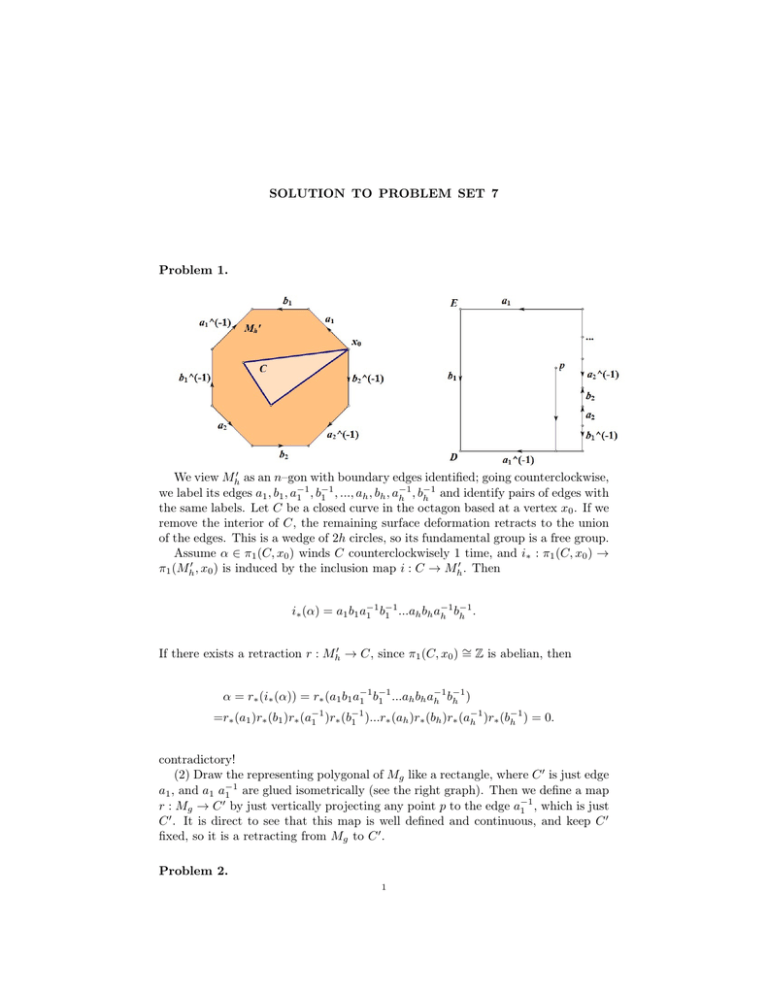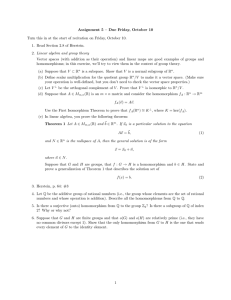SOLUTION TO PROBLEM SET 7 Problem 1. We view M
advertisement

SOLUTION TO PROBLEM SET 7
Problem 1.
We view Mh0 as an n–gon with boundary edges identified; going counterclockwise,
−1
−1 −1
we label its edges a1 , b1 , a−1
1 , b1 , ..., ah , bh , ah , bh and identify pairs of edges with
the same labels. Let C be a closed curve in the octagon based at a vertex x0 . If we
remove the interior of C, the remaining surface deformation retracts to the union
of the edges. This is a wedge of 2h circles, so its fundamental group is a free group.
Assume α ∈ π1 (C, x0 ) winds C counterclockwisely 1 time, and i∗ : π1 (C, x0 ) →
π1 (Mh0 , x0 ) is induced by the inclusion map i : C → Mh0 . Then
−1
−1 −1
i∗ (α) = a1 b1 a−1
1 b1 ...ah bh ah bh .
If there exists a retraction r : Mh0 → C, since π1 (C, x0 ) ∼
= Z is abelian, then
−1
−1 −1
α = r∗ (i∗ (α)) = r∗ (a1 b1 a−1
1 b1 ...ah bh ah bh )
−1
−1
−1
=r∗ (a1 )r∗ (b1 )r∗ (a−1
1 )r∗ (b1 )...r∗ (ah )r∗ (bh )r∗ (ah )r∗ (bh ) = 0.
contradictory!
(2) Draw the representing polygonal of Mg like a rectangle, where C 0 is just edge
a1 , and a1 a−1
1 are glued isometrically (see the right graph). Then we define a map
r : Mg → C 0 by just vertically projecting any point p to the edge a−1
1 , which is just
C 0 . It is direct to see that this map is well defined and continuous, and keep C 0
fixed, so it is a retracting from Mg to C 0 .
Problem 2.
1
2
SOLUTION TO PROBLEM SET 7
We can deform this cylinder to make arcs α and β straight. (By, for instance,
twisting the cylinder around a vertical axis.) Then it is not hard to see that
π1 (D2 × I − (α ∪ β), x0 ) =< a, b >∼
= Z ∗ Z, where a represents the loop winding
α 1 time and b represents the loop winding β 1 time. Consider the disc section
containing γ, we can see that [γ] = αβα−1 β −1 is a nonzero in Z ∗ Z. So there is no
nullhomotopy of γ in D2 × I − (α ∪ β).
Problem 3.
(1) Rm+n+2 obviously has an orthogonal decomposition as
Rm+n+2 = Rm+1 ⊕ Rn+1
. Assume our S m and S n are standard unit sphere in the subspaces Rm+1 and
Rn+1 respectively. Now we define the map
f : S m ∗ S n →S m+n+1 ⊂ Rm+n+2
[(x, y, t)] 7→
(1 − t)x + ty
.
|(1 − t)x + ty|
It is not hard to check that this map is well defined and continuous and bijective. Further, since S m ∗ S n is compact and S m+n+1 is Hausdorff, f is actually a
homeomorphism.
(2) Suppose that (X, x0 ) and (Y, y0 ) are path–connected based spaces. Let
X̄ = X × Y × 1/ ∼
Ȳ = X × Y × 0/ ∼ .
These are homeomorphic to X and Y respectively. Furthermore, the neighborhoods
A = X × Y × (1/3, 1]/ ∼ and B = X × Y × [0, 2/3)/ ∼ deformation retract to X̄
and Ȳ respectively. We thus apply van Kampen’s theorem: we have A ∩ B = X ×
Y × (1/3, 2/3), so π1 (A) = π1 (X), π1 (B) = π1 (Y ), and π1 (A ∩ B) = π1 (X) × π1 (Y ).
Let iBA : A ∩ B → A, iAB : A ∩ B → B. These inclusions induce maps
(iBA )∗ : π1 (X) × π1 (Y ) → π1 (X) and (iAB )∗ : π1 (X) × π1 (Y ) → π1 (Y ) which
are projection to the first and second factors respectively. Van Kampen’s theorem
implies that there is a surjective homomorphism Φ : π1 (X)∗π1 (Y ) → π1 (X ∗Y ) with
kernel normally generated by elements of the form iAB (γ)iBA (γ)−1 ; if γ = (α, β),
these have the form βα−1 . But these elements include every element of π1 (X) and
π1 (Y ), so Φ is the zero map.
If Y is not path-connected, let Y = ∪λ Yλ , where Yλ ’s are the disjoint connected
open path components of Y . Then X ∗ Y = ∪λ (X ∗ Yλ ), and X ∗ Yλ is pathconnected for each λ. Unfortunately, X ∗ Yλ is not open – in order to make it open,
SOLUTION TO PROBLEM SET 7
3
let Aλ = X ∗ Yλ ∪ A, where A = X × Y × (1/3, 1]/ ∼. Then Aλ is a path-connected
open set that deformation retracts to X ∗ Yλ .
For all λ1 6= λ2 , we have Aλ1 ∩ Aλ2 = A. This is path-connected, so by van
Kampen’s theorem, there is a surjective homomorphism
Φ : ∗λ π1 (Aλ ) → π1 (X ∗ Y ).
But π1 (Aλ ) = 0 for all λ, so π1 (X ∗ Y ) = 0.
Problem 4.
(1) Assume n is the number of deleted points, we can prove by induction on n.
For n = 1, the space has a deformation retraction to the sphere S 2 and is simply
connected.
Now assume that we have proved this theorem for 1, ..., n − 1. For the case with
n points deleted, assume the set of n points are A = {(xi , yi , zi )}ni=1 . W.L.O.G we
may assume x1 6= x2 . Choose a, b such that x1 < a < b < x2 and a, b 6= xi for
any i. Now let X1 = {(x, y, z) : x < b}, X2 = {(x, y, z) : x > a}. Then X1 , X2
are homeomorphic to R3 and has at most n − 1 deleted points, by the induction
assumption we have π1 (X1 − A) ∼
= π1 (X2 − A) ∼
= 0. By van Kampen’s theorem
there is a surjective homomorphism from π1 (X1 −A)∗π1 (X2 −A) ∼
= 0 to π1 (R3 −A).
3
So π1 (R − A) = 0.
(2) W.L.O.G we may assume the k-dimensional subspace is
A = {(xi )n : x1 = ... = xn−k = 0} ∼
= {0} × Rk .
i=1
Then Rn − A ∼
= (Rn−k − {0}) × Rk . Now it suffices to prove Rn−k − {0} is simply
connected. This is because Rn−k − {0} has a natural deformation retraction to the
unit sphere S n−k−1 , which is simply connected when n − k − 1 ≥ 2.
Problem 5.
Let x0 be the center of D, and A = Y − {x0 } and B is a small open ball
neighborhood of x0 in D. Then A has a deformation retraction to X and A ∩ B
has a deformation retraction to an (n − 1)-dimensionnal sphere. So B and A ∩ B
are simply connected and π1 (A) ∼
= π1 (X). By van Kampen’s theorem π1 (Y ) ∼
=
π1 (A) ∗ π1 (B)/N for some normal subgroup N which is actually trivial by the fact
π1 (A ∩ B) ∼
= 0. So π1 (X) ∼
= π1 (A) ∼
= π1 (Y ).
Problem 6.
4
SOLUTION TO PROBLEM SET 7
By identifying opposite vertices, edges, and faces in the surface of a cube, we
can see that the 1-skeleton X1 becomes the right graph above, which is homotopic
equivalent to S 1 ∨ S 1 ∨ S 1 . So π1 (X1 , D) =< α, β, γ >∼
= Z ∗ Z ∗ Z, where α =
[adb−1 ], β = [bec−1 ], γ = [cf a−1 ]. In the 2-skeleton X2 , there are 3 cells attached
along [bef a−1 ] = βγ, [cf db−1 ] = γα, [adec−1 ] = αβ respectively. So
π1 (RP 2 ) =< α, β, γ|αβ, βγ, γα >=< α|α2 >∼
= Z/2Z.


